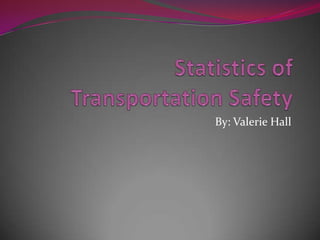Transportation Safety Valerie Hall
- 1. Statistics of Transportation Safety By: Valerie Hall
- 2. Probability using not.What is the probability of not dying in a fatal airplane crash in 1980?
- 3. Answer There was a total of 5,479 airplane departures in 1980. Among these departures 19 airplanes crashed. The probability of being in a fatal accident in 1980 is 19/5,479. in order to find the probability of not crash you subtract 1 from 19/5,479 which is 5,460/5479.
- 4. Prbability using not.What is the probability of not dying in a fatal airplane crash in 1990?
- 5. AnswerThere was a total of 8,092 airplane departures in 1990. Among these departures 39 airplanes crashed. The probability of being in a fatal accident in 1990 is 39/8,092. In order to find the probability of not crash you subtract 1 from 39/8,092 which is 8053/8092.
- 6. Probability of two mutually exclusive events.What is the Probability of dying in a fatal airplane crash in 2001 or 2003?
- 7. AnswerThe probability of dying in a fatal airplane crash in 2001 is 92/11,468 and in 2003 was 22/10,508. in order to find the probability of to exclusively mutual situations you have to add the two probability. 92/11,468 plus 22/10,508 is .0101159659.
- 8. Probability of two mutually exclusive events.What is the probability of dying in a fatal airplane crash in 1997 or 1996?
- 9. AnswerThe probability of dying in a fatal airplane crash in 1996 is 380/8,229 and in 1997 was 8/10,980. In order to find the probability of to exclusively mutual situations you have to add the two probability.380/8,229 plus 8/10,980 is .0469067479.
- 10. Probability using andWhat is the probability of the same amount of crash will occur in a consecutive years (1966 and 1967)?
- 11. AnswerWhen finding the probability using add you multiply the total outcomes. 8,229 times 10,318 =84,906,822
- 12. Work citedNational Transportation Statisticshttp://www.bts.gov/publications/national_transportation_statistics/html/table_02_09.htmlBudge text ŌĆ£Thinking MathematicallyŌĆØ Third edition. Blitzer (pg.579-604)












